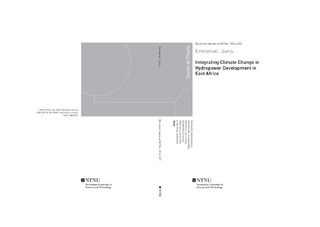| dc.description.abstract | The main objective of this study was to quantify the impacts of climate change on hydropower resources in East Africa thereby providing a basis for integrating the impact of Climate Change in hydropower development in the region. It was important to address the impact of climate change since it is was perceived as a potential threat to sustainability of renewable energy resources such as hydropower, yet renewable energy sources are a leading option for meeting growing energy demand and also for mitigating climate change.
The magnitude of climate change projections for Africa, the variation in space of expected changes in temperature and precipitation across Africa, the few Regional Climate modelling attempts for most of Africa and hence the uncertainty in existing information, further justified the need for more studies especially at finer spatial scales (for example on a level of a catchment area of a power plant and on power systems). The perceived differences in climate across the East African region also justified the need for analysis that can be used to design regional strategies for developing and sharing hydropower and other energy resources between the countries to maximise the benefits in the face of climate change.
The research questions that were;
_ What are the trends in historical precipitation and runoff records over 1961{1990 in the study region and how do they compare with general climate trends?
_ What methodology and tools are required for th analysis of climate change impacts on hydropower?
_ What are the expected impacts of climate change on existing hydropower systems?
_ What is the mitigation potential of hydropower (i.e. how much unexploited potential) can be available and what methods/tools can be developed to quickly estimate the technical potential over a large area?
A review of existing studies was made in order to to establish a methodology building on previous work of a similar nature and to document the known situation regarding hydropower and climate change and hydropower in East Africa. This provided an opportunity to comprehend some of the limitations of the methods is use today and suggest approaches for the different scales of assessment. The methodology used combines downscaling of GCM (Globa lClimate Model) outputs, Hydrological modelling (Rainfall run-off modelling), hydropower production simulation as well as mapping of new hydropower resources to determine the climate change mitigation potential of hydropower and climate change impact also on not yet developed hydropower schemes.
The results and conclusions regarding the key research questions were;
1. Trends in observed series
Annual and monthly trends in precipitation appear stationary over all the East African rainfall regions. Differences in trend values are seen when trends are computed for the seasons DJF, MAM, JJA, and SON. MAM typically has a mean positive trend while SON has a mean negative trend. It appears that generally the increases observed in the MAM season are offset by decreases in the SON season. The trend analysis is not very conclusive given the sparse station network and the quality of data for a number of stations (i,e, missing values). Inter-annual variability in precipitation is observed to be quite strong. With respect to runoff, on an aggregated scale, it appears that the runoff in East Africa remained stable over the period 1961{1990 even if individual rivers show varying runoff over time.
2. Methodology and tools
A methodology for the analysis has been developed, used and documented. A Tools (scripts) to seamlessly enable the downscaling and hydrological modelling process for the study of the impact on hydrology have been developed. The studies can easily be replicated by applying these tools. The tool has been used to generate runoff scenarios using the SRES A1B scenario and GCMs that were analysed to gave a good simulation of the historical observed climate or the region.
3. The Impacts on existing hydropower systems
Climate change models predict a steady increase in temperature for the region and generally increases in precipitation of different magnitudes depending on location of the catchment. Changes in runoff are generally positive but downstream of lake Victoria (Victoria Nile) the runoff changes have larger magnitude than in the rest of the smaller catchments. The runoff downstream lake victoria is as a result of the increased water balance of the lake. Climate change is likely to positively impact hydropower in the region. The existing hydropower system will show some changes in hydropower production but the installed capacity is not sufficient to put the extra water to use in hydropower generation. There is a need to optimise each power station`s operation strategies and to develop a gradual strategy for increasing the capacity at several power plants if climate changes are sustained.
4. Climate change mitigation potential of hydropower
A tool for mapping technical hydropower potential has been developed, verified and applied to part of the region (Uganda). Results show that there is still a lot of potential that can be deployed compared to previous studies for example by the Inter-national Journal of Hydropower and Dams (IJHD). The use of hydropower to meet energy demands and to mitigate climate change in the region still has a large potential. In Uganda this study has established that the hydropower potential could be up to 3 times what is officially documented.
There are still opportunities to improve the outcomes of this research. The key challenge has been the quality of observed data records. Work on improving these records will further enable better results and monitoring of climate changes. The tools developed during this study can enable the simulations to be extended to cover larger areas more easily. | nb_NO |
